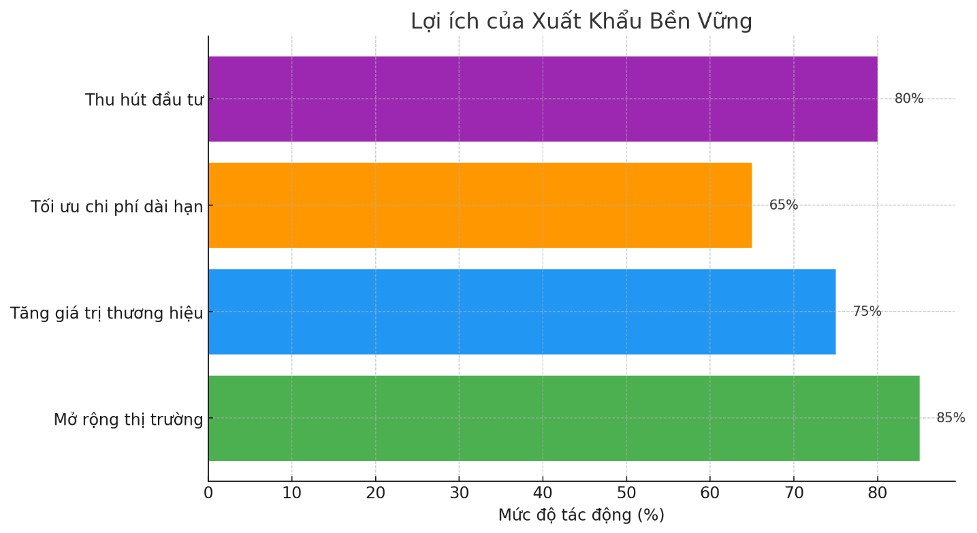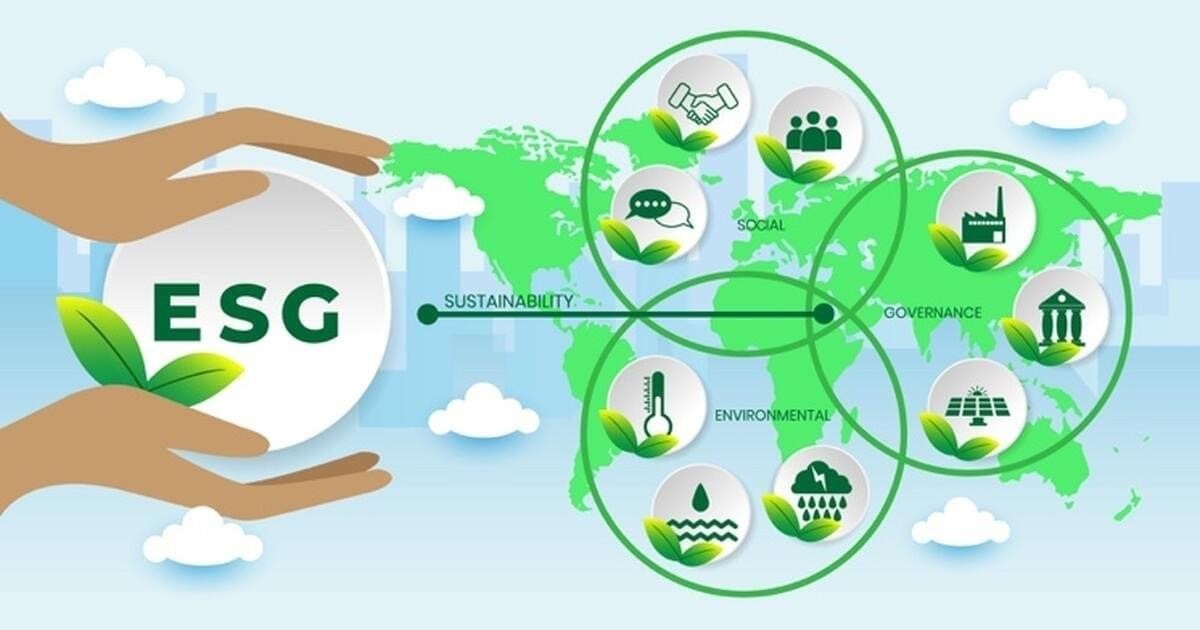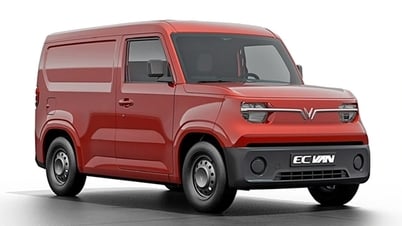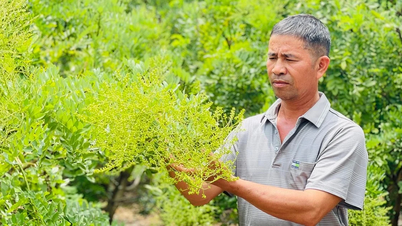Sustainable exporting is not just about bringing goods to international markets, but also ensuring environmental, social and governance (ESG) factors.
In the context of global economic integration, export is not only an important growth driver but also a measure of the competitiveness of Vietnamese enterprises in the international arena. However, to reach out and establish a solid position, enterprises cannot only focus on quantity or price, but need to aim for a sustainable export strategy.
Sustainable exporting is not just about increasing turnover, but also about optimizing the supply chain, ensuring green standards, complying with international regulations and building a brand with long-term value. In the context of major markets increasingly tightening environmental, labor and social responsibility standards, this is no longer an option but a mandatory condition for businesses to survive and develop.
 |
| Sustainable export is not simply about increasing turnover. Photo: Xuan Toan |
So, what do Vietnamese businesses need to do to realize the goal of sustainable export? What opportunities and challenges await on this journey? Let's find out in the article below.
Sustainable exporting brings big benefits
Sustainable exporting is not just about getting goods to international markets, but also about ensuring environmental, social and governance (ESG) factors. This includes minimizing negative environmental impacts, complying with labor regulations and demonstrating responsibility to communities, as well as ensuring transparency and compliance with international law.
Important criteria for sustainable exports include: First, the environment, reducing greenhouse gas emissions, using recycled materials and saving energy. For example, under the European Union (EU) Green Deal, products imported into this market must meet strict environmental standards, including reducing emissions and using sustainable materials.
Second, it is social, complying with labor regulations and demonstrating responsibility to the community. Consumers are increasingly concerned about transparency, traceability, sustainability and social responsibility of product production chains.
Third, governance ensures transparency and compliance with international laws. Several countries, including the UK, Australia, France and Germany, have passed laws that strengthen due diligence requirements to address supply chain and sustainability risks.
According to data from the General Statistics Office, Vietnam's export volume has increased from 96.91 billion USD in 2011 to 786.29 billion USD in 2024, an increase of 8.1 times. However, the expansion of production risks increasing pollution pressure due to the exploitation of many natural resources. Moving towards sustainable exports not only helps businesses meet international standards, but also builds prestige and enhances competitiveness in the global market.
Sustainable exporting brings great benefits in terms of market, finance and brand, helping businesses develop in the long term. The benefits of sustainable exporting are shown in the following chart:

The chart above shows the benefits of sustainable exports: Expanding markets (85%) Meeting green standards helps access demanding markets such as the EU and the US. Because these markets increasingly prioritize products with sustainability certification, creating opportunities to expand market share. Increasing brand value (75%), businesses are highly appreciated for their social and environmental responsibilities, helping businesses build reputation and increase the trust of customers and partners. Optimizing long-term costs (65%), saving costs using renewable materials, optimizing energy helps reduce long-term production costs. Investing in renewable energy, optimizing processes helps businesses save operating costs in the long term. Attracting investment (80%), green businesses are more likely to receive financial support and international cooperation. Investors are increasingly interested in businesses with sustainable strategies, promoting capital flows. Reducing regulatory compliance risks helps avoid trade barriers and green tariffs. Environmental protection reduces emissions, uses resources sustainably, and conserves biodiversity.
Identifying challenges and solutions for Vietnamese businesses
Vietnamese businesses are facing many challenges in applying ESG standards and green technology such as: High initial investment costs, deploying green technology solutions and achieving sustainability certification requires significant capital. In particular, small and medium enterprises (SMEs) often have difficulty mobilizing finance for these projects.
According to the World Bank, SMEs in Vietnam face high ESG start-up costs, especially in investing in new technology, processes and staff training. With margins thin, ESG implementation is often seen as a burden rather than an opportunity.
In addition, Vietnamese businesses often lack understanding of international regulations. Many businesses do not fully understand ESG standards and import requirements of international markets. A survey by PwC shows that 66% of businesses in Vietnam have not yet integrated ESG into their business strategies or are just starting. The main reason is the lack of effective support tools to manage and monitor ESG data.
 |
| With thin margins, ESG implementation is often seen as a burden rather than an opportunity for Vietnamese businesses. |
Along with that, the supply chain is not optimized and ensuring the supply chain meets sustainability standards is a big challenge. Many businesses do not have the ability to control their entire supply chain, leading to raw materials, production and transportation not meeting sustainability standards.
According to a 2023 study by Sustainalytics, only 30% of Vietnamese enterprises have complete ESG reports, while the remaining 70% do not report or only provide fragmented information that does not comply with international standards.
Above all, there is competition with foreign enterprises. Foreign enterprises often have advantages in technology and experience in applying ESG standards. This creates great competitive pressure on Vietnamese enterprises. According to PwC's 2024 report, 93% of listed enterprises commit to ESG, higher than the Vietnamese average of 80%. Of which, the number of enterprises implementing ESG comprehensively is still limited.
Solutions proposed for Vietnamese enterprises to move towards sustainable exports: First, raise awareness and long-term strategies for sustainable exports. According to the General Department of Customs, Vietnam's export turnover will reach 405.53 billion USD in 2024, but green barriers such as CBAM (EU Carbon Border Adjustment Mechanism) could affect 40% of exports to the EU from 2026. PwC's ESG criteria research shows that 73% of global investors tend to choose ESG-compliant enterprises. However, only 30% of Vietnamese enterprises have a clear ESG plan.
Second, improve products according to green standards. According to Nielsen, 81% of consumers are willing to pay more for green products. Businesses can take advantage of recycled materials such as paper packaging (reducing 30% of plastic costs) or organic fabrics (reducing 50% of CO2 emissions compared to traditional cotton). Energy-saving technology in solar-powered factories such as Vinamilk has saved 20% of electricity costs, reducing 15,000 tons of CO2/year.
Third, comply with regulations and obtain international certification. Sustainability certification of enterprises with FSC (sustainable forest certification) can increase the selling price of products by 15-20%. Textile exports with GOTS (global standard for textile products made from organic fibers) help access the EU market more easily, where the market value of organic textiles is forecast to reach 12.7 billion USD by 2028. The government's green export support program has spent 30,000 billion VND on green projects and support enterprises to access the EU market.
Fourth, invest in sustainable supply chains. Enterprise-standard suppliers such as VinFast have reduced emissions from their supply chains by 60% when working with ESG-certified suppliers. According to the World Bank, optimizing and improving logistics can reduce transportation costs by 10-15%, helping Vietnamese businesses increase their competitiveness in exports.
Fifth, apply technology and digital transformation. Blockchain in the supply chain, an IBM study shows that blockchain can reduce 30-50% of supply chain management costs and help make product origins transparent. AI and IoT, factories using AI to optimize production can reduce 30% of raw material waste and increase productivity by 20%.
Sixth, international cooperation and market expansion. Thanks to the EVFTA, agricultural exports to the EU will increase by 17% in 2023. With the CPTPP, import taxes on Canada and Japan will be reduced from 15% to 0%, helping Vietnamese textiles and garments expand their market share. Or supporting export enterprises, the USAID business support program has helped more than 300 Vietnamese enterprises access the US market in the past 3 years.
| Moving towards sustainable exports not only helps businesses meet international standards, but also builds reputation and enhances competitiveness in the global market. |
Source: https://congthuong.vn/xuat-khau-ben-vung-chia-khoa-de-doanh-nghiep-viet-vuon-xa-373973.html





![[Photo] National Assembly Chairman Tran Thanh Man meets with Thai Prime Minister Paetongtarn Shinawatra](https://vphoto.vietnam.vn/thumb/1200x675/vietnam/resource/IMAGE/2025/5/15/e71160b1572a457395f2816d84a18b45)
![[Photo] Prime Minister Pham Minh Chinh receives Country Director of the World Bank Regional Office for Vietnam, Laos, Cambodia](https://vphoto.vietnam.vn/thumb/1200x675/vietnam/resource/IMAGE/2025/5/15/2c7898852fa74a67a7d39e601e287d48)










































































Comment (0)